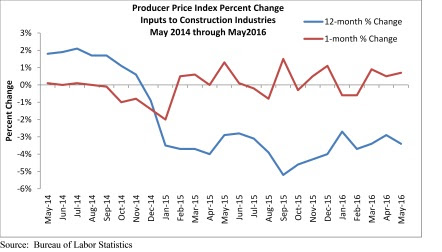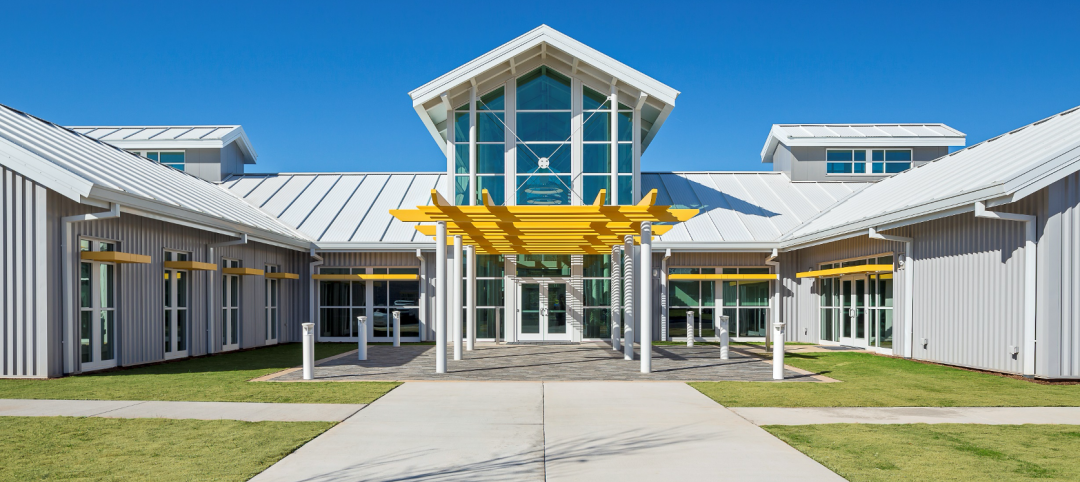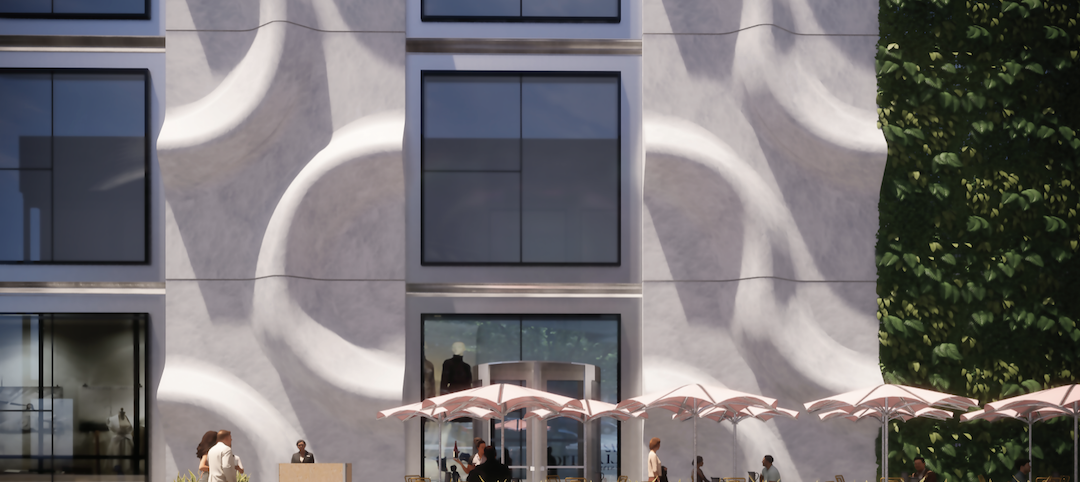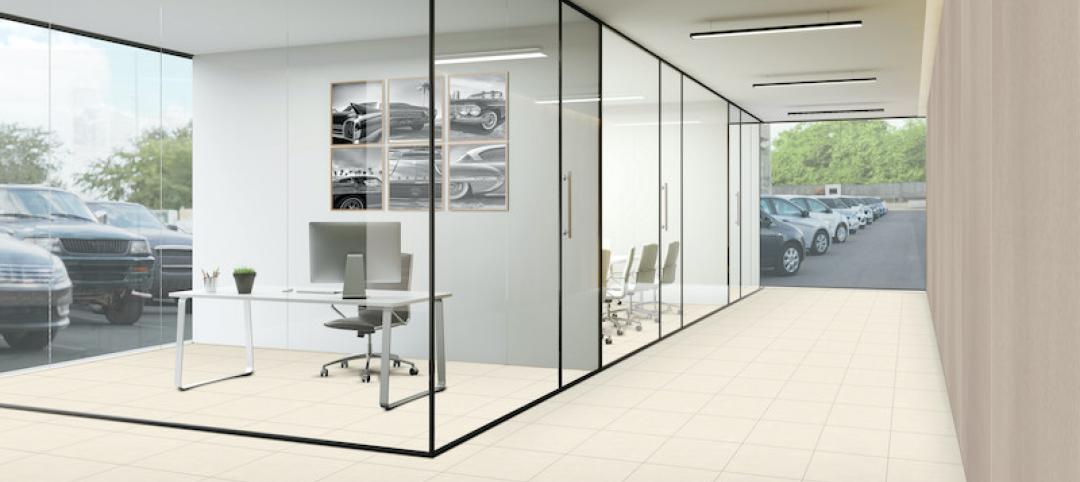Construction input prices expanded by 0.7% in May and have now expanded for three consecutive months according to an analysis of the Bureau of Labor Statistics Producer Price Index released by Associated Builders and Contractors (ABC). The rise follows eight consecutive months during which construction input prices fell; prices remain 3.4% below their year-ago level.
Nonresidential construction input prices expanded by 0.9% in May, but are still 3.5% below their year-ago level. Price gains were largely driven by iron and steel prices and steel mill product prices, which expanded 5.8% and 4.6% for the month, respectively.
"After falling sharply during all of 2015 and into the early months of 2016, an increase in global commodities prices had to happen as markets firmed," said ABC Chief Economist Anirban Basu. "While much attention has been given to the recent rise in oil prices to around $50 per barrel, other commodity prices have also experienced a resurgence, including iron ore.
"That said, the global economy continues to disappoint relative to expectations established at the start of the year," said Basu. "Higher prices may stimulate new rounds of production, including in energy markets, but the implication is that prices are unlikely to rise smoothly or dramatically going forward. Analyst views regarding the direction of commodity prices diverge wildly. While supply and demand play a role in fashioning commodity prices, so too does the value of the U.S. dollar. U.S. interest rates remain low and in many cases have been declining. The dollar has correspondingly weakened in recent weeks. Should that continue, commodity price increases could be sharper than we presently anticipate."

Nine key input prices expanded or remained unchanged in May on a monthly basis:
- Crude petroleum prices expanded 0.6% from April 2016, but are down 32.5% from May 2015.
- Unprocessed energy material prices expanded 0.9% on a monthly basis, but have fallen 23.1% on a year-ago basis.
- Prices for steel mill products expanded 4.6% from a month ago, but are down 5.2% on a yearly basis.
- Iron and steel prices expanded 5.8% month-over-month, but are down 2% year-over-year.
- Softwood lumber prices expanded 2.2% for the month and 6.3% from May 2016.
- Fabricated structural metal prices remained unchanged month-over-month and are down 1.9% year-over-year.
- Prices for plumbing fixtures and fittings expanded 0.2% for the month and are up 0.3% from the same time last year.
- Prices for prepared asphalt and tar and roofing and siding products expanded by 0.4% month-to-month and 0.7% year-over-year.
- Natural gas prices rose 2.9% for the month, but are down 23.5% from the same period one year ago.
Two key input prices declined on a monthly basis:
- Nonferrous wire and cable prices fell 1.3% on a monthly basis and have fallen 9.2% on a yearly basis.
- Concrete product prices inched down by 0.1% month-over-month, but are up 3% year-over-year.
Related Stories
Sponsored | BD+C University Course | May 5, 2022
Designing with architectural insulated metal wall panels
Insulated metal wall panels (IMPs) offer a sleek, modern, and lightweight envelope system that is highly customizable. This continuing education course explores the characteristics of insulated metal wall panels, including how they can offer a six-in-one design solution. Discussions also include design options, installation processes, code compliance, sustainability, and available warranties.
Sponsored | BD+C University Course | May 3, 2022
For glass openings, how big is too big?
Advances in glazing materials and glass building systems offer a seemingly unlimited horizon for not only glass performance, but also for the size and extent of these light, transparent forms. Both for enclosures and for indoor environments, novel products and assemblies allow for more glass and less opaque structure—often in places that previously limited their use.
Sponsored | BD+C University Course | Apr 19, 2022
Multi-story building systems and selection criteria
This course outlines the attributes, functions, benefits, limits, and acoustic qualities of composite deck slabs. It reviews the three primary types of composite systems that represent the full range of long-span composite floor systems and examines the criteria for their selection, design, and engineering.
Wood | Apr 13, 2022
Mass timber: Multifamily’s next big building system
Mass timber construction experts offer advice on how to use prefabricated wood systems to help you reach for the heights with your next apartment or condominium project.
Sponsored | BD+C University Course | Apr 10, 2022
Designing with commercial and industrial insulated metal wall panels
Discover the characteristics, benefits and design options for commercial/industrial buildings using insulated metal panels (IMPs). Recognize the factors affecting panel spans and the relationship of these to structural supports. Gain knowledge of IMP code compliance.
Building Materials | Feb 17, 2022
3D-printed megapanels, unitized window-wall assemblies now available from Sto Corp.
Panel manufacturer is collaborating with Branch Technology and Kawneer North America on prefabrication solutions for building facades.
3D Printing | Jan 12, 2022
Using 3D-printed molds to create unitized window forms
COOKFOX designer Pam Campbell and Gate Precast's Mo Wright discuss the use of 3D-printed molds from Oak Ridge National Lab to create unitized window panels for One South First, a residential-commercial high-rise in Brooklyn, N.Y.
Building Materials | Nov 29, 2021
Daltile expands its Unity Collection of porcelain tiles with a new color
Addition of "Taupe" gives Daltile's Unity Collection three warm and three cool colors.
Urban Planning | Nov 11, 2021
Reimagining the concrete and steel jungle, SOM sees buildings that absorb more carbon than they emit
The firm presented its case for a cleaner built environment during the Climate Change conference in Scotland.
Sustainability | Oct 28, 2021
Reducing embodied carbon in construction, with sustainability leader Sarah King
Sustainability leader Sarah King explains how developers and contractors can use the new EC3 software tool to reduce embodied carbon in their buildings.

















